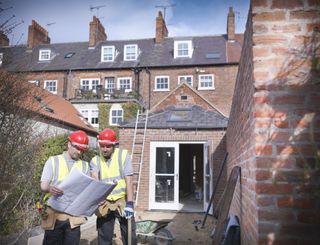12 Reasons Your Building Estimate May Be Wrong
Building estimates are just that — estimates — however, they're an important factor in budgeting for your build. Here's why they're not always accurate

There's no doubt that your builder will press home that a building estimate is a best guess, not the final figure that your project will cost, but with the financing of the project often hanging its hat on the estimate, any large deviations could prove problematic for the build.
While it's possible to do your best to cost control a build as you're going along, if the estimate is way off in the first place, it will be almost impossible to bring down the price, no matter how much you put cost efficiency ahead of the design.
So why might an estimate go wrong? Though the estimating process can be quite simple, there are some key areas in which they're vulnerable to increases in costs. Keep them in mind, and you may have the foresight to avoid or budget for extra costs.
1. Material Price Increases
In the current building boom, there is a serious shortage of materials and labour across the industry. Some materials have doubled in recent months and some are becoming very scarce. There are also forecasts of yet more price rises, again some as much as double — timber, insulation, cement, landscaping products to name a few.
(MORE: Construction Materials Shortage Set to Continue, and Prices Could Keep Rising)
Micro and SME building contractors cannot afford to absorb these increases so have to pass it on to the customer. If you are intrigued about some of the costs, just ask, as we are more than happy to explain the price rises that are going on. A good builder will work closely with their various suppliers to keep abreast of price increases and shortages of materials.
2. False Benchmarking
Get an more accurate estimate for your build project with our Extension Cost Calculator and Build Cost Calculator.
Benchmarking is an ‘early doors’ means of guessing how much a project will cost. Note the deliberate use of the word ‘guessing’. In essence, you take a previous project, measure it in m2, and multiply this cost by your new dimensions (a little more to it than that but that is the bones of it). Then you apply this rate to your own project.
The trouble is you are comparing your scheme to one which was built at a different time, in a different place, by different people, using different materials. Build costs can vary between £300-£3,000/m2 due to the differences alluded to above — are you really comparing like with like?
3. Assumptions
If you don’t know something, making an assumption is your best guess of the right solution. This applies to specification, methods of working, access requirements, logistical support, delivery timeslots, lead-in times — the list goes on.
If you assume something, bear in mind you are essentially guessing with a hint of education attached — that’s all. And the accuracy of that guess is often open to the other parties’ own assumptions or guesses. One man’s assumption is another man’s opportunity to make money. Guess at your peril!
4. Unclear or Incomplete Design
If something is unclear, different people will interpret it in different ways. If your design is open to interpretation, or has large elements yet to be cleared up, using provisional sums is useful but still leads to potential inaccuracy.
The aim with any provisional is to allow enough money to cover the issue, but in more cases than not, this usually being slightly on the lower end of expectations to make the initial estimates more optimistic. Detail is the only sure way to establish prices.
(MORE: 7 Reasons Your Builders' Quotes are Beyond Budget)
5. Innovative Construction Techniques or Design Details
A major benefit of self build and renovation is the ability to engage with ‘off-piste’ techniques, innovative design and cutting-edge technology and materials. However, do not ever associate these with traditional costing and lower build prices.
Bespoke (or even niche) design has a price attached. It affects material prices but, perhaps more so, builders will struggle to accurately price for things that look out of the ordinary. The ability to get the lowest price is closely associated with using tried and tested methods, materials and systems — the economy of scale associated with the best prices from merchants, contractors and suppliers is well served here.
6. Estimate Lag
Price increases in labour and materials is bad news for estimates that aren’t very recently completed. A homeowner going back to a builder to confirm a go-ahead on an estimate supplied six months ago might find that their figures are no longer relevant, which will affect the whole planning process.

7. Specification Change
Changing your mind is the main concern here — change costs money. It affects the estimate because it starts the ‘add and omit’ process. Change is where contractors do very well out of contracts.
Change is often necessary, and the beauty of being in charge is the ability to satisfy your desires and requests — just be warned that change costs, and your cost control and forecasting abilities will be stretched, and your estimate will start to slip.
(MORE: 15 Ways to Stay on Budget)
8. Procurement
In basic terms, the more accurate your design and the more risk and control you put onto the contractor, the more you can be confident that your precontract estimate of costs will be accurate.
At the opposite end of the procurement spectrum, engaging trades on a weekly rate and buying your own materials gives you great hands-on control, but threatens your estimate as it is harder to control or predict timings (and therefore wage bills) and your own procurement of materials is of paramount importance.
(MORE: Tips for Buying at a Builders Merchant)
9. Measure all the Work, Not Just the Headlines
When estimating costs, measurement of the work from the drawings and specification is vital. The main point here is that appreciating the full scope of the work is key. If we consider brickwork, for example, measuring the elevations will give you a good guess as to the overall job, but check that you have included the ‘extra overs’ — raking cuts at gables, forming cavities, weep holes, pointing after scaffold removal, band courses, building in lintels, etc. should all be accounted for.
In other words, measure all the work, not just the headlines. And make sure you impart this to the supply chain, rather than just getting a quote from the bricklayer for construction of ‘X’m2 of face brickwork.
10. Time and the Programme
The programme affects the estimate. Winter working, drying times, working hours externally with natural daylight — the time of year when the work is carried out will affect costs.
Increases in time as the work progresses through delays, changes or procurement issues will all impact on the estimate profoundly as prelims and site management will increase, follow-on trades may be disrupted, and you may need to find different contractors (at different prices!) to keep to programme. The forgotten enemy of the estimate is the programme and its impact on cost.
(MORE: A Typical Self Build Schedule)
11. Wastage
Understanding the impact of wastage allowances is vital in estimating — not just making sure you have allowed enough material and time to carry out the measured works, but have also included accurate and realistic wastage considerations. Take flooring, for example. A tiled floor laid with straight, square bonding (joints) is relatively efficient. At the edges, you will probably get two cuts out of one plain single colour floor tile — i.e cutting the tile to fit in at the edge is probably going to leave enough on that tile to use reversed on another edge. However, introduce a chequer board pattern and the number of reusable cut tiles diminishes. Add angles or changes in the bond and this diminishes even more. The amount of wastage can run from 10 percent to in the region of 40 per cent for intricate patterns, to much higher numbers where different colours, patterns and bond are employed.
The design informs the working method which informs the wastage allowance. Make sure when estimating that this is thought about. Even planning ceiling heights can impact on this — 2.4m celling heights enable full-height plasterboard to be used with little wastage. While 2.5m requires small sections of board to be cut to complete the wall and 2.3m-high plasterboard will require 100mm of board to be thrown away with little chance of use elsewhere. When estimating, these considerations have an impact.
12. Logistics and Prelims
The unsung supporting cast of the building programme, these are the items which make the site run smoothly, safely and correctly. Access equipment, delivery procedures, site toilets, debris removal, management costs, printing of documentation, site insurances — all these need paying for but are easily overlooked when estimating costs as they are not directly associated with or measurable from the drawings.
As a case in point, a typical build requires a 6m3 skip per week on site for general debris, as well as the skips for specific identified tasks. This could add circa £275 a week to the cost of the build without anything tangible being constructed. But failing to get rid of the rubbish as it accrues is fatal in terms of efficiency.
(MORE: How to Get Rid of Rubble)
Get the Homebuilding & Renovating Newsletter
Bring your dream home to life with expert advice, how to guides and design inspiration. Sign up for our newsletter and get two free tickets to a Homebuilding & Renovating Show near you.
Bob is one of the UK’s leading Chartered Surveyors and with over 30-years’ experience in both self build and construction. A career spent with several main contractors and major surveying consultancies has helped reinforce his approach that cost-estimating and control are a fundamental tenet of self building. He's previously led seminars at Homebuilding & Renovating Shows across the country.
